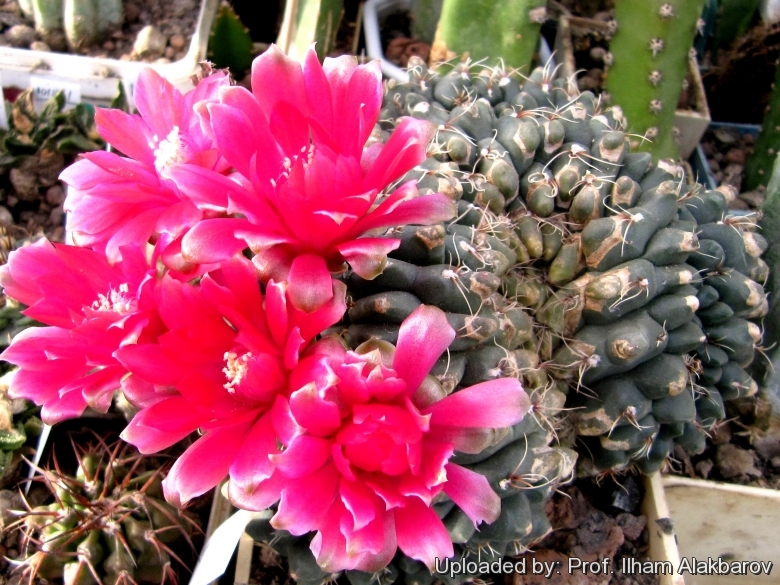Accepted Scientific Name: Gymnocalycium baldianum Speg.
Anales Soc. Ci. Argent. xcix. 135 (1925)

Gymnocalycium baldianum f. cristata Photo by: Prof. Ilham Alakbarov
Origin and Habitat: Garden origin (Nursery produced cultivar)
Synonyms:
See all synonyms of Gymnocalycium baldianum
back
Accepted name in llifle Database:Gymnocalycium baldianum Speg.Anales Soc. Ci. Argent. xcix. 135 (1925)Synonymy: 9
Cultivars
(1):
back
Description: Gymnocalycium baldianumSN|26130]]SN|11968]] is a small usually unbranched species with rich purple-red blooms, sometimes pinkish-purple.
Crested form: The crested form Gymnocalycium baldianum f. cristataSN|11968]]SN|26130]] - despite to its beauty - is still very rare and sought after by collectors, for its unique features.
Stem: Fan shaped, somewhat flattened and depressed along the line meristem, up to 10 cm in width, green, greyish-brown to blue-green (rather variable in colour in cultivation, and in some specimens it is almost blue-black).
Ribs: Broad divided by deep grooves into tubercles.
Areoles: Deep-set.
Spines: 5 to 7 thin radial spines that are straight or curved toward the stem, short, curved, pale brown or grey, tinged with red at the base.
Flowers: Produced on the crown near the apex, measuring 3 to 4 cm in length and the same across, open wide in sunlight, and commonly of a most rich purple-red colour, sometimes pinkish-purple (but also white, pink or orange). The stamens are purple, the anthers and the 6 lobed stigma whitish yellow. This plant blooms in early summer when it is only 2,5 cm.
Fruits: The ripened ovary is green, long and dehisces (splits) down its length.
Subspecies, varieties, forms and cultivars of plants belonging to the Gymnocalycium baldianum group
Bibliography: Major references and further lectures
1) Edward F. Anderson “The Cactus Family” Timber Press, 2001
2) Curt Backeberg “Cactus Lexicon” Sterling Publishing Company, Incorporated, 1978
3) David Hunt, Nigel Taylor “The New Cactus Lexicon” DH Books, 2006
4) James Cullen, Sabina G. Knees, H. Suzanne Cubey “The European Garden Flora Flowering Plants: A Manual for the Identification of Plants Cultivated in Europe, Both Out-of-Doors and Under Glass” Cambridge University Press, 11/Aug./2011
5) Perea, M. & Trevisson, M. 2013. Gymnocalycium baldianum. In: IUCN 2013. "IUCN Red List of Threatened Species." Version 2013.2. <www.iucnredlist.org>. Downloaded on 25 February 2014.
Cultivation and Propagation: Gymnocalycium baldianumSN|11968]]SN|11968]] is very easy to grow, these plants offer no cultivation difficulties.
Watering Needs: Moderate to copious in summer, keep dry in winter.
Frost Tolerance: Quite frost resistant if kept dry -10° C (Temperature Zone: USDA 8-10 )
Cultural Practices: Feed with a high potassium fertilizer in summer.
Sun Exposure: Full sun to light shade.
Crested growth: Unlike 'monstrose' varieties of plants, where the variation from normal growth is due to genetic mutation, crested growth can occur on normal plants. Sometimes it's due to variances in light intensity, or damage, but generally the causes are unknown. A crested plant may have some areas growing normally, and a cresting plant that looks like a brain, may revert to normal growth for no apparent reason. If you have any of the crested part left you need to remove the normal growth and leave the crested part behind this will need to be done regularly.
Propagation: Grafting or cuttings. Plants are usually grafted onto column-shaped cacti but proved to be able to produce their own roots if degrafted. Cuttings will take root in a minimum temperature of 20° C (but better in hot weather). Cuttings of healthy shoots can be taken in the spring and summer. Cut the stem with a sharp, sterile knife, leave the cutting in a warm, dry place for a week or weeks (depending on how thick the cutting is) until a callus forms over the wound. Once the callus forms, the cutting may be inserted in a container filled with firmed cactus potting mix topped with a surface layer of coarse grit. They should be placed in the coarse grit only; this prevents the cut end from becoming too wet and allows the roots to penetrate the rich compost underneath. The cuttings should root in 2 to 6 weeks. Large crested piece must be placed on the soil surface without burying the plant base down in the soil.










